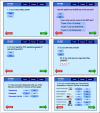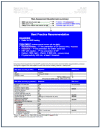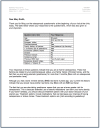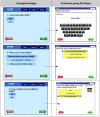Development of a prototype clinical decision support tool for osteoporosis disease management: a qualitative study of focus groups
- PMID: 20650007
- PMCID: PMC2914714
- DOI: 10.1186/1472-6947-10-40
Development of a prototype clinical decision support tool for osteoporosis disease management: a qualitative study of focus groups
Abstract
Background: Osteoporosis affects over 200 million people worldwide, and represents a significant cost burden. Although guidelines are available for best practice in osteoporosis, evidence indicates that patients are not receiving appropriate diagnostic testing or treatment according to guidelines. The use of clinical decision support systems (CDSSs) may be one solution because they can facilitate knowledge translation by providing high-quality evidence at the point of care. Findings from a systematic review of osteoporosis interventions and consultation with clinical and human factors engineering experts were used to develop a conceptual model of an osteoporosis tool. We conducted a qualitative study of focus groups to better understand physicians' perceptions of CDSSs and to transform the conceptual osteoporosis tool into a functional prototype that can support clinical decision making in osteoporosis disease management at the point of care.
Methods: The conceptual design of the osteoporosis tool was tested in 4 progressive focus groups with family physicians and general internists. An iterative strategy was used to qualitatively explore the experiences of physicians with CDSSs; and to find out what features, functions, and evidence should be included in a working prototype. Focus groups were conducted using a semi-structured interview guide using an iterative process where results of the first focus group informed changes to the questions for subsequent focus groups and to the conceptual tool design. Transcripts were transcribed verbatim and analyzed using grounded theory methodology.
Results: Of the 3 broad categories of themes that were identified, major barriers related to the accuracy and feasibility of extracting bone mineral density test results and medications from the risk assessment questionnaire; using an electronic input device such as a Tablet PC in the waiting room; and the importance of including well-balanced information in the patient education component of the osteoporosis tool. Suggestions for modifying the tool included the addition of a percentile graph showing patients' 10-year risk for osteoporosis or fractures, and ensuring that the tool takes no more than 5 minutes to complete.
Conclusions: Focus group data revealed the facilitators and barriers to using the osteoporosis tool at the point of care so that it can be optimized to aid physicians in their clinical decision making.
Figures










Similar articles
-
Usability evaluation of a clinical decision support tool for osteoporosis disease management.Implement Sci. 2010 Dec 10;5:96. doi: 10.1186/1748-5908-5-96. Implement Sci. 2010. PMID: 21143978 Free PMC article.
-
Evaluation of a clinical decision support tool for osteoporosis disease management: protocol for an interrupted time series design.Implement Sci. 2011 Jul 22;6:77. doi: 10.1186/1748-5908-6-77. Implement Sci. 2011. PMID: 21781318 Free PMC article.
-
Factors influencing implementation of a computerized, individualized, culturally tailored lupus decision aid in lupus clinics: a qualitative semi-structured interview study.Clin Rheumatol. 2019 Oct;38(10):2793-2801. doi: 10.1007/s10067-019-04643-w. Epub 2019 Jun 20. Clin Rheumatol. 2019. PMID: 31222574
-
[Psychometric characteristics of questionnaires designed to assess the knowledge, perceptions and practices of health care professionals with regards to alcoholic patients].Encephale. 2004 Sep-Oct;30(5):437-46. doi: 10.1016/s0013-7006(04)95458-9. Encephale. 2004. PMID: 15627048 Review. French.
-
Avoiding and identifying errors in health technology assessment models: qualitative study and methodological review.Health Technol Assess. 2010 May;14(25):iii-iv, ix-xii, 1-107. doi: 10.3310/hta14250. Health Technol Assess. 2010. PMID: 20501062 Review.
Cited by
-
Developing a patient and family-centred approach for measuring the quality of injury care: a study protocol.BMC Health Serv Res. 2013 Jan 27;13:31. doi: 10.1186/1472-6963-13-31. BMC Health Serv Res. 2013. PMID: 23351430 Free PMC article.
-
Usability evaluation of a clinical decision support tool for osteoporosis disease management.Implement Sci. 2010 Dec 10;5:96. doi: 10.1186/1748-5908-5-96. Implement Sci. 2010. PMID: 21143978 Free PMC article.
-
Primary care physicians' views on osteoporosis management: a qualitative study.Arch Osteoporos. 2019 Apr 26;14(1):48. doi: 10.1007/s11657-019-0599-9. Arch Osteoporos. 2019. PMID: 31028556 Free PMC article.
-
Exploring the role of professional identity in the implementation of clinical decision support systems-a narrative review.Implement Sci. 2024 Feb 12;19(1):11. doi: 10.1186/s13012-024-01339-x. Implement Sci. 2024. PMID: 38347525 Free PMC article.
-
District nurses' perceptions of osteoporosis management: a qualitative study.Osteoporos Int. 2015 Jul;26(7):1911-8. doi: 10.1007/s00198-015-3086-1. Epub 2015 Mar 20. Osteoporos Int. 2015. PMID: 25792490
References
-
- National Osteoporosis Society. http://www.nos.org.uk/ Accessed on April 10, 2009.
-
- Osteoporosis Canada. http://www.osteoporosis.ca/english/home/ Accessed on February 23, 2007.
Publication types
MeSH terms
Grants and funding
LinkOut - more resources
Full Text Sources
Medical

